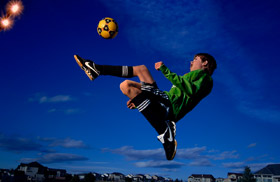 Hi, and welcome to this edition of Workshop at the Ranch. By the time this issue is posted I will already be in Torino, Italy covering the Winter Olympics. I will not be reading or responding to any emails during the month of February…so please save your questions and emails for sometime in March…thanks.
Hi, and welcome to this edition of Workshop at the Ranch. By the time this issue is posted I will already be in Torino, Italy covering the Winter Olympics. I will not be reading or responding to any emails during the month of February…so please save your questions and emails for sometime in March…thanks.
This past year I received more emails requesting additional instruction using the Nikon SB800 Speedlights than any other topic. These little giants of light have brought new life to my location portraiture and even some action assignments.
Hi, and welcome to this edition of Workshop at the Ranch. By the time this issue is posted I will already be in Torino, Italy covering the Winter Olympics. I will not be reading or responding to any emails during the month of February…so please save your questions and emails for sometime in March…thanks.
This past year I received more emails requesting additional instruction using the Nikon SB800 Speedlights than any other topic. These little giants of light have brought new life to my location portraiture and even some action assignments.
I have always liked the moody lighting style that is created when a sunlit environment is under exposed by a stop and the subject is lit by strobes. I like the image even more when the White Balance is set to cool (moody blue) the under exposed sunlit environment and the strobe has a warming gel to light the subject with warm light…(Robert Seal of the Sporting News is famous for his very stylized location portraits). The hassle was not this formula for creating a stylized picture but that I have to bring a strobe with enough watts/second to over power the sun and achieve a one stop under exposed environment (ex: 1/250 sync speed of the camera with an aperture of f16 at ISO100). A normal hotshoe strobe reaches light to a subject about 3 feet away at f16 and it drains the battery too. It can also be overwhelming lugging around heavy and expensive battery packs, lightstands, soft boxes, sand bags …etc. onto the playing field, track, velodrome, ski slope for a “quick” portrait…..and there aren’t many AC outlets on the beach that I have ever seen. If only the sync speed were faster when I used a flash, like 1/2000 or 1/4000 or more!…….WOW, then I could use an aperture of f5.6 or f4 or even f2.8. No more f16 draining the life from my strobe. The Nikon SB800 Speedlights are a terrific answer. They are small, powerful, remote, have i-TTL capability and allow the photographer to sync at shutter speeds up to 1/8000 of a second. Having the ability to use a high shutter speed which then allows me to use an aperture like f2.8 or f4 for an outdoor portrait in full sunshine opens up so many possibilities. Here are some examples……………
***The camera and SB800 set up used for image #1 can be used as a general model or formula for the next three images. The settings might vary slightly depending on the amount of depth of field I want and how stylized I want the light to reveal my subject from the environment.***
|
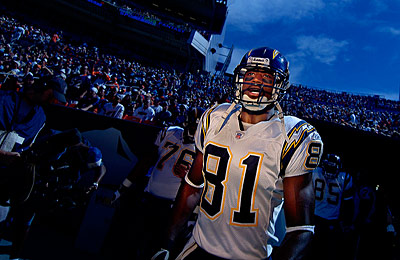 Image #1 I photographed many “on the run” location portraits this football season. This basic formula was used: I determine the exposure for the environment and then underexposed the image purposely by 1 stop. I set my WB at 3600K which cools (blue) the environment (background). I must set the Nikon D2X Flash Sync Speed Setting on Auto FP (custom setting e1 ….this allows the camera to sync with Nikon SB800 Speedlights at shutter speeds higher than 1/250.) I then used 2 SB800 Speedlights strapped together (tandem) creating twice the power in a remote, handheld package. I also placed the warming gel that comes standard with each SB800 over each of the remote Speedlights to counter the cool WB of 3600K environment and light my subject with warm light that resembles golden sunset lighting. A few test shots on a sideline volunteer helped me determine how much to dial up or down the power output of the remote “tandem” SB800s from the Master. The Master SB800 on the hotshoe of my Nikon D2X is only used as a Master (set with no power output of its own) to set the power output of my remotes, relay the i-TTL information and trigger the tandem remotes. The result is that my subject’s face and chest area is revealed from the under exposed cool environment with warm light from the remote tandem SB800s creating a stylized picture while on the run. Nikon D2X, ISO100, 1/2500 at f5, WB 3600K, Nikon 12-24mm Lens, the remote tandem SB800 Speedlights as described in this article are set at a power output of +2.3, Lexar 4G Flash Card. Image #1 I photographed many “on the run” location portraits this football season. This basic formula was used: I determine the exposure for the environment and then underexposed the image purposely by 1 stop. I set my WB at 3600K which cools (blue) the environment (background). I must set the Nikon D2X Flash Sync Speed Setting on Auto FP (custom setting e1 ….this allows the camera to sync with Nikon SB800 Speedlights at shutter speeds higher than 1/250.) I then used 2 SB800 Speedlights strapped together (tandem) creating twice the power in a remote, handheld package. I also placed the warming gel that comes standard with each SB800 over each of the remote Speedlights to counter the cool WB of 3600K environment and light my subject with warm light that resembles golden sunset lighting. A few test shots on a sideline volunteer helped me determine how much to dial up or down the power output of the remote “tandem” SB800s from the Master. The Master SB800 on the hotshoe of my Nikon D2X is only used as a Master (set with no power output of its own) to set the power output of my remotes, relay the i-TTL information and trigger the tandem remotes. The result is that my subject’s face and chest area is revealed from the under exposed cool environment with warm light from the remote tandem SB800s creating a stylized picture while on the run. Nikon D2X, ISO100, 1/2500 at f5, WB 3600K, Nikon 12-24mm Lens, the remote tandem SB800 Speedlights as described in this article are set at a power output of +2.3, Lexar 4G Flash Card.
|
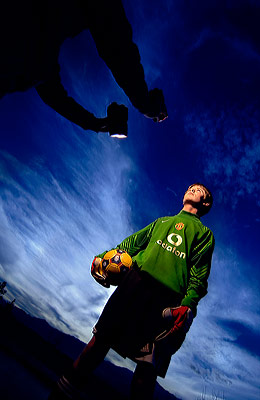 Image #2 The classic application for this formula is generally found in stylized sport and fashion portraiture. I will shoot directly against the sun….why?, … because I like the way the clouds are illuminated…simple as that. This image illustrates the use of 4 remote SB800 Speedlights (2 groups of 2 SB800s.) The tandem SB800s in my assistant’s right hand is designated Group A on the Master and is aimed at the Goalie’s face and has a power out put of +3 while the tandem SB800s in his left hand is designated Group B on the Master and is aimed at the soccer ball and has an out put of +2. Brad is standing approximately 7 feet from our subject. Each SB800 is zoomed to 85mm to help narrow the throw of light…(this helps create some interesting fall off shadows on my subject for some extra mood.) I determine the exposure for the environment (take a shot-take a look…the sky is ISO100 1/3200 at f4), then I under expose the scene as much or as little as I want….I choose 1 stop darker…ISO100, 1/6400 at f4 and use a WB of 3600K to cool (blue) the sky which is my environment (background). Then I bring the subject in and tell my assistant where to aim the Speedlights and take a shot-take a look. Not bad for the first frame but the my LCD screen on the D2X camera is indicating a flashing highlight on our subjects forehead. The Group A remote tandem Speedlights that illuminate the goalie’s face have too much power output, so I dialed the power down a little on Group A from +3 to +2.3. Image #2 The classic application for this formula is generally found in stylized sport and fashion portraiture. I will shoot directly against the sun….why?, … because I like the way the clouds are illuminated…simple as that. This image illustrates the use of 4 remote SB800 Speedlights (2 groups of 2 SB800s.) The tandem SB800s in my assistant’s right hand is designated Group A on the Master and is aimed at the Goalie’s face and has a power out put of +3 while the tandem SB800s in his left hand is designated Group B on the Master and is aimed at the soccer ball and has an out put of +2. Brad is standing approximately 7 feet from our subject. Each SB800 is zoomed to 85mm to help narrow the throw of light…(this helps create some interesting fall off shadows on my subject for some extra mood.) I determine the exposure for the environment (take a shot-take a look…the sky is ISO100 1/3200 at f4), then I under expose the scene as much or as little as I want….I choose 1 stop darker…ISO100, 1/6400 at f4 and use a WB of 3600K to cool (blue) the sky which is my environment (background). Then I bring the subject in and tell my assistant where to aim the Speedlights and take a shot-take a look. Not bad for the first frame but the my LCD screen on the D2X camera is indicating a flashing highlight on our subjects forehead. The Group A remote tandem Speedlights that illuminate the goalie’s face have too much power output, so I dialed the power down a little on Group A from +3 to +2.3. |
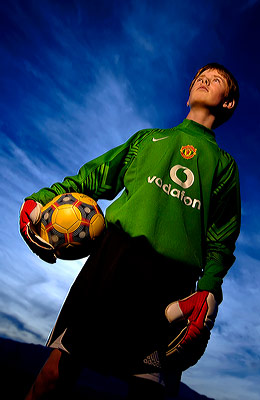 Image #3 Image #3 The next frame looks better now that the Group A remote tandem SB800s are dialed down to +2.3. I can now recompose and shoot. The convenience of increasing or decreasing the power output directly from the Master SB800 on the hotshoe of the D2X keeps me working with my subject and not running around adjusting lights and power packs. Nikon D2X, ISO100, 1/5000 at f4, WB3600K, Nikon 12-24mm Lens, the SB800 Speedlights are as described, Lexar 4G Flash Card. In general, the same formula as image #1 with some modifications that included an additional remote tandem SB800 set up to light more than just our subjects face and chest. The SB800s with warming gels reveal about 3/4 of my subject and the soccer ball from being silhouetted against the under exposed 3600K cool (moody blue) environment with a warm sunset light produced by the remote SB800 Speedlights.
|
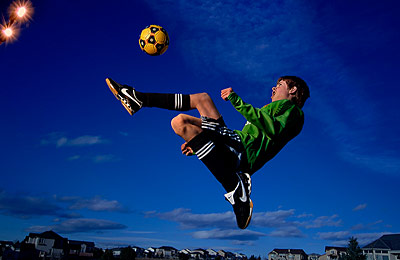 Image #4 This image uses the same stylized moody blue formula as our portrait, but thanks to the Nikon D2X FP Flash Sync Speed custom setting allowing me to sync at faster than 1/250, I can also freeze the action. Instead of facing into the setting sun, (image #3) I have repositioned myself to the opposite side of my subject. Why?….because now I liked the clouds forming in the Northeast sky…simple as that. This change of position took less than 1 minute whereas if I were using power packs, softboxes, lightstands etc. it would have taken 30 minutes to set up again. The Northeast sky exposure was 1/1250 at f4 so I under exposed 1 stop to 1/2500 at f4, same basic formula as before, same equipment, same 2 groups of tandem Speedlights hand held by my assistant, Brad standing to my left and about 8 feet from our subject (see Speedlights in the upper left-hand corner of the image). My subject is jumping on a trampoline so as to perform his bicycle kick above the houses. The SB800 Speedlights made it much easier for Brad to follow our jumping subject rather than having lightstands and fixed positioned strobes, power packs, sand bags, cords, etc. The i-TTL capability of the SB800s keeps the subject lit consistently while flying through the air, therefore I kept the power output the same as the portrait with Group A set at +2.3 and Group B set at +2. We had a gusty wind situation that normally makes outdoor location lighting unnerving, but with the ease of the hand held Nikon SB800s my biggest concern of the shoot was chasing the soccer ball when it flew over the fence a few times. Image #4 This image uses the same stylized moody blue formula as our portrait, but thanks to the Nikon D2X FP Flash Sync Speed custom setting allowing me to sync at faster than 1/250, I can also freeze the action. Instead of facing into the setting sun, (image #3) I have repositioned myself to the opposite side of my subject. Why?….because now I liked the clouds forming in the Northeast sky…simple as that. This change of position took less than 1 minute whereas if I were using power packs, softboxes, lightstands etc. it would have taken 30 minutes to set up again. The Northeast sky exposure was 1/1250 at f4 so I under exposed 1 stop to 1/2500 at f4, same basic formula as before, same equipment, same 2 groups of tandem Speedlights hand held by my assistant, Brad standing to my left and about 8 feet from our subject (see Speedlights in the upper left-hand corner of the image). My subject is jumping on a trampoline so as to perform his bicycle kick above the houses. The SB800 Speedlights made it much easier for Brad to follow our jumping subject rather than having lightstands and fixed positioned strobes, power packs, sand bags, cords, etc. The i-TTL capability of the SB800s keeps the subject lit consistently while flying through the air, therefore I kept the power output the same as the portrait with Group A set at +2.3 and Group B set at +2. We had a gusty wind situation that normally makes outdoor location lighting unnerving, but with the ease of the hand held Nikon SB800s my biggest concern of the shoot was chasing the soccer ball when it flew over the fence a few times.
|
The more I use these SB800 Speedlights the more I find applications for them and the more interesting the pictures I produce. This formula is not the only way to light outdoors but is to be used as a guideline to which your own lighting situations can be created.
Remember…..by the time you read this Workshop at the Ranch I will already be in Italy for my 12th Olympic Games. I will not be reading or responding to any emails during the month of February … so please hold any emails or questions you might have for sometime in March…thanks.
Well…..Get ready for some Winter Olympic images next time at Workshop at the Ranch.
Adios, Dave
![]() Hi, and welcome to this edition of Workshop at the Ranch. By the time this issue is posted I will already be in Torino, Italy covering the Winter Olympics. I will not be reading or responding to any emails during the month of February…so please save your questions and emails for sometime in March…thanks.
Hi, and welcome to this edition of Workshop at the Ranch. By the time this issue is posted I will already be in Torino, Italy covering the Winter Olympics. I will not be reading or responding to any emails during the month of February…so please save your questions and emails for sometime in March…thanks.





